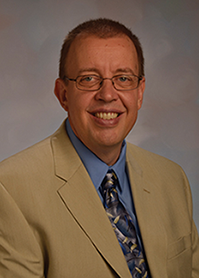Hanno Weitering Elected AAAS Fellow
January 26, 2022

Hanno Weitering
Hanno Weitering has found his niche as a scientist and leader, and now as a fellow of the American Association for the Advancement of Science (AAAS).
Weitering, professor and head of the Department of Physics and Astronomy, was selected “for outstanding contributions to the fundamental understanding of correlated phenomena at interfaces and in thin films and for distinguished academic leadership.”
His success is rooted in following scientific curiosity and, from time to time, engaging in some neighborly intellectual sparring.
Growing up in a suburb outside the Dutch city of Rotterdam, Weitering was always interested in science. Chemistry edged out other subjects, but just barely. When he took senior exams in high school his marks across languages and literature, math, and science were almost identical. His chemistry grade, however, was just a tiny bit higher. He decided that would be a good path to follow and went on to earn a master’s degree in chemistry at the University of Groningen, followed by a PhD. He moved to physics when he accepted a Benjamin Franklin Postdoctoral Fellowship at the University of Pennsylvania, though the shift wasn’t all that drastic.
"I did inorganic solid state chemistry," Weitering explained. "In essence that’s so close to condensed matter physics it was actually a small step."
Condensed matter is the science of the material world. Semiconductors, transistors, and liquid-crystal displays all trace their origins to the field. Here, just a few atomic layers of one element atop another can give rise to exotic properties like superconductivity, where electric current flows with no resistance. Working out what happens at the surface, or where the layers meet, is territory Weitering knows well.
"I’m interested in novel materials’ properties," he said. "When you have materials with very complex properties, people try to develop theoretical models that simplify the problem and advance our understanding. I try to reduce the complexity of the material but go after the same physics. Can I develop a simple platform where these models would be a much better match?"
It turns out he can, and he counts carving out this niche as some of his best scientific work.
Weitering and his colleagues charted new ground when they devised a novel superconductor from the ground up by modifying a conventional semiconductor. The system requires only a few tin atoms “decorating” a silicon surface. It’s a simple platform, but one with surprising and potentially useful properties. Fundamental studies like these are the basis for breakthroughs often taken for granted.
"Materials physics is really important for developing new materials for technological applications, although they may not yet be around the corner," Weitering said. "It took 40 years or so between the conception of the transistor and large-scale commercial success."
While applications may be down the road, it’s a small miracle Weitering’s novel superconductor ever came to be.
"I had vowed earlier in my career that I would never work in superconductivity," he joked.
That changed when he shared office space with, and later next door to, Jim Thompson (now professor emeritus).
"Jim taught me the essentials of superconductivity," he said. "The best ideas come forward when you work with others. You need intellectual sparring partners."
Weitering, who came to UT in 1993, joins an impressive list of intellectual partners with the AAAS fellowship. The association describes fellows as a “distinguished cadre of scientists, engineers and innovators who have been recognized for their achievements across disciplines, from research, teaching, and technology, to administration in academia, industry and government, to excellence in communicating and interpreting science to the public.” The 2021 class includes 564 scientists, engineers, and innovators across scientific disciplines. (Physics Professors Elbio Dagotto and Adriana Moreo are also AAAS fellows.)
Weitering was elected not only for his research accomplishments but also his academic leadership. When he put his name forward for the headship in 2012, he saw it as both a responsibility to serve the department and an opportunity to make a difference. Though it would mean less time in his lab, he said he decided "as long as I have fun doing my science and I can still do it, that’s a nice position to be in."
He’s proud of the scientists who’ve joined the faculty during his tenure and is looking forward to the bright future he sees for the university’s Quantum Materials for Future Technologies cluster. Still, after 10 years as department head and (previously) 10 as deputy director of UT’s Joint Institute for Advanced Materials*, Weitering is ready for his full-time return to the faculty August 1. While he hasn’t ruled out future leadership roles, he’d like to first ramp up his research. With the increasingly collaborative and international nature of science, he sees a promising horizon to develop new materials, with a shorter distance to practical uses.
"There are a lot more ideas and discoveries to be made," he said. "As usual, the most exciting ones are those we fail to foresee."
*Now the Institute of Advanced Materials and Manufacturing (IAMM)